Zones
Fish diagrams •
MRI images •
Primitive vs. derived features •
Single fins •
Paired fins, etc. •
Hard parts: scales, teeth, skeleton •
Connecting inside-and-out •
Insides: internal organs •
_____________________________________
At first glance, there are so many different kinds of fishes that they appear randomly distributed, but if you look in detail, patterns emerge. Certain body characteristics are more common in particular environments.
Fishes that live in clear and sunny coral reefs are noticeably different from those that live in muddy rivers. Reef fishes tend to be brightly-colored while those that live in murky water tend to be mud-colored. Fishes that come out a night are different from those that come out during the day. Those that live on the bottom differ from those that swim above. In the open blue ocean, many fishes tend to be dark on their backs and silvery on their undersides.
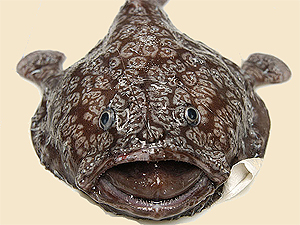
Sight, appearance and camoflauge that are so valuable in sunlit places are not as useful in the dark where alternative ways of "seeing" and being seen dominate. In murky places, whisker-like barbels allow catfishes to smell food they cannot see. Lanternfishes light up in the deep dark for reasons that we don't fully understand.
About half of fishes live in freshwater terrestrial environments such as lakes and streams while the other half live in the oceans. The physiological cost of dealing with differences between saltwater and freshwater is so great that few fishes can tolerate both. Depending on where they live, fishes have complex ways of dealing with excess salt and water accumulation in their bodies. Fishes adapted to both salt and fresh water, including salmon, eels and bull sharks are unusual.
Of the marine fishes, the greatest variety and volume live close to land in waters above the continental shelves that rim continents. The greatest density of species are found associated with coral reefs.
Before we go on, explore the diagtram below to learn more about different zones.
The diel (daily) veritical migration

The largest migration on Earth takes place every day when fishes, animal plankton (zooplankton) and other invertebrates rise from the depths at sunset and come out of hiding to feed closer surface dwellers. At sunrise, these same animals descend back to the depths to hide for the day. This migration is called the diel vertical migration.
Lanternfishes such as the myctophids shown here can make up large portions of the migrating fauna.
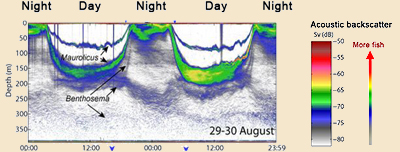
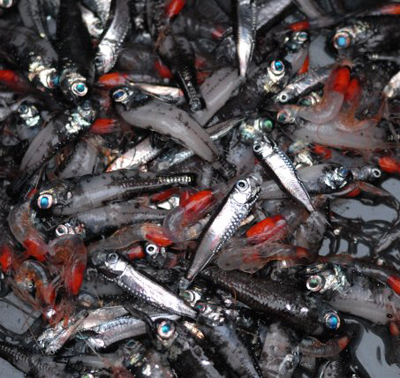
Catches of two species, Benthosema glaciale and Maurolicus muelleri. (below) Permission pending-Norwegian Ocean Observatory Network
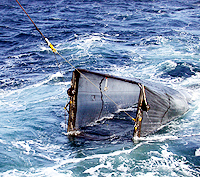


Deep water environments



See also:
Rockfishes of the Genera Sebastes and Sebastologus Seafood Watch Seafood Report, Montery Bay Aquarium
When it's your life on the line, details count. Because some species of rockfish have become particularly scarce in the eastern Pacific along U.S. and Canada coasts, understanding detailed differences among the 72 species that occupy this area is a priority. With that knowledge, we can answer questions such as, how many fish can be safely harvested and how should we fish for these species?
When some rockfish such as a Honeycomb Rockfish (Sebastes umbrosus) are hauled up, it's apparent that they don't deal well with the drop in pressure. Many rockfishes come up with their eyes popped out, sides distended and stomachs protruding through their mouths. Other fish don't have this problem even though they venture into deeper waters.
For a fish like the rockfish, does catch-and-release work? Check out the brochure from California Sea Grant. Part of the problem is separating the rockfish and knowing what you have. Even in the grocery store, multiple species have been lumped under the name rockfish, red snapper or rock cod. The rockfishes are neither true red snappers or types of cod, although several species may now be called red snappers. The fishes we refer to as rockfishes are the fishes in the genus Sebastes and Sebastolobus. Rock fish live near and at the bottom in the coastal region from the nearshore areas out over the continental shelf and down to about 800 m below sea level on continental slopes. Some like to live on rocky substrates. They are good sized fish for eating, for example the possibly threatened Canary rockfish Sebastes pinniger grows to weigh about 10 pounds.
The nearshore rocky seafloor off California, Oregon and Washington is home to
The rockfishes (Sebastes spp.) include many fishes that are valuable recreational and commercial fishes that live near the seafloor off the coast of California. Since their numbers had been dwindling over the last several decades, the rockfish fisheries of California have been of Catch and release seems like a good idea to help fish survive. But it depends on the fish.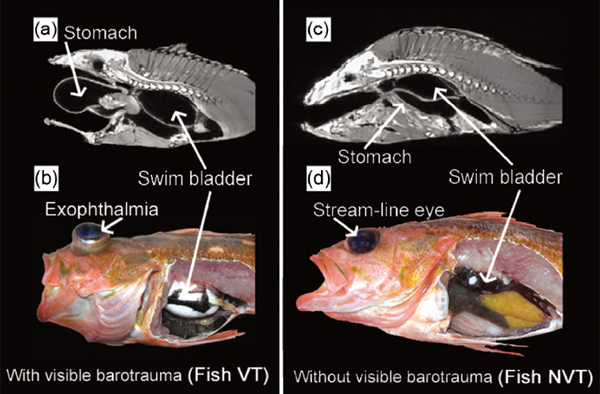
The environments of fishes
Equator-to-Pole environmental variation
Availability of sunlight
Since of the Earth is spherical, the concentration of sunlight that falls on the sea surface decreases at higher latitude towards each pole.Since the Earth's axis of rotation is tilted with respect to it's orbital plane around the Sun, each pole experiences total darkness during its respective winter months.
Sea surface temperature
Since the concentration of sunlight that falls on the Earth's surface decreases toward's the poles, the temperature at the sea surface decreases towards the poles.Sea surface temperature maps exhibit an overall "zonal" pattern. A zonal pattern is one in which bands of similar temperature run parallel to the equator in the east-west direction. (In contrast, a meridional pattern runs parallel to lines of longitude in the north-south direction.)
Sea surface salinity
The zonal pattern of sunlight results in a generally zonal pattern of rainfall across the Earth. Rainfall is highest in the tropics near the equator and poleward at high latitude beyond 60° N and S. Rainfall is low in both hemispheres in zonal bands around 30° N and S.Depending on the balance between evaporation and precipiation, the salinity at the sea surface also exhibits a zonal pattern on Earth. Evaporation concentrates salinity and precipitation dilutes it. The equator is bathed in relatively low salinity water because although it's hot, rainfall is high. Near 30&ndeg; N and S, where it rains little and it's moderately warm, salinity is high.
The differences in sea surface salinity across the open ocean are still relatively small. The greatest salinity variation ioccurs where freshwater rivers flow into the saline ocean, and among separate bodies of terrestrial aquatic environments.
Sea surface nutrient availability
At the surface of the ocean, nutrients such as nitrate and phosphate limit biological productivy at the base of the food. The pattern of nutrient concentration in surface waters is generally zonal because it depends on the Earth's wind pattern that is generally zonal..Depth-related environmental variation
Sunlight
Sunlight comes into the ocean from the top.Water is nearly transparent and allows light to pass through without being absorbed very much, yet the ocean gets darker with depth.
As sunlight moves into the ocean, it is absorbed by pigments in plankton and by other materials that are suspended in seawater. Sunlight that has been absorbed no longer illuminates the water. Areas of the ocean with high concentrations of living things and sediment are darker at shallower depths.
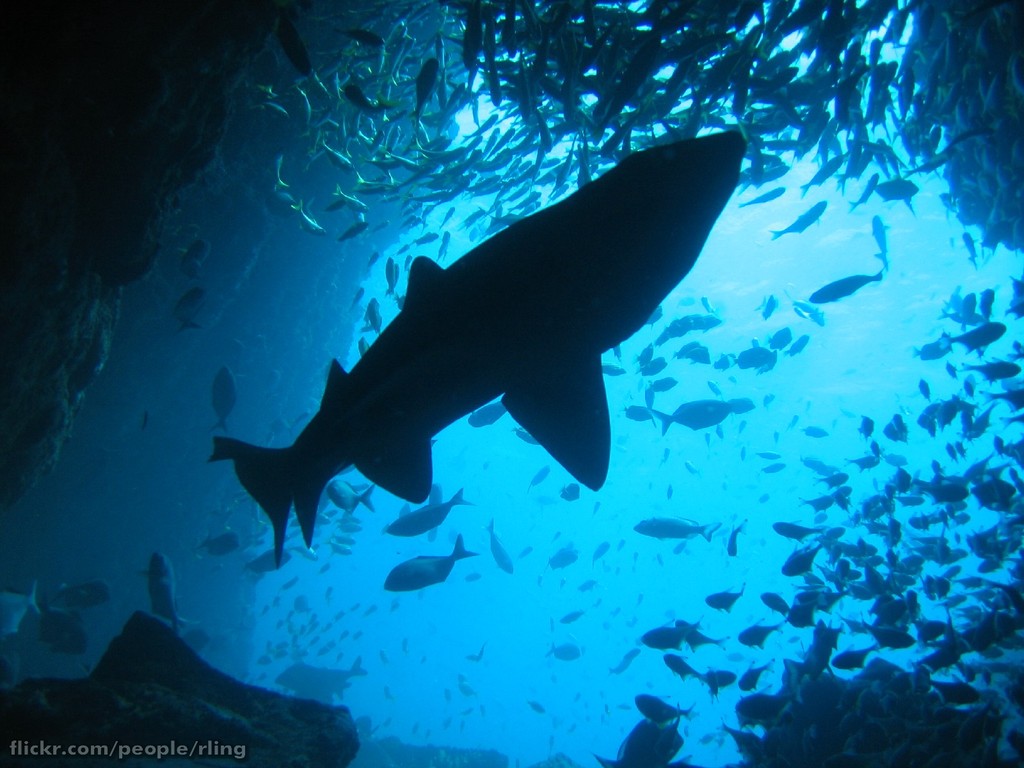
Silhouettes of fish in a skyward-looking view.
Oxygen Availability
Since the only part fo the ocean in contact with air is at its surface, the concentration of oxgyen is highest at its surface.However, most of the ocean including the deep parts are well oxgygenated because of the way deep water circulates around the Earth today.
In the modern oceans, anoxia only occurs in restricted areas and within the sediment that lies at the bottom of the oceans.
Mid-depth waters can have unusually low low oxygen conentrations because it's too far from the surface for resupply yet high concentration of animals still live there and utilize the available oxygen.
Food Web
Since the main food web in the ocean relies on photosynthesis, photosynthesizers that make up the base of the food web grow where sunlight is abundant. Unlike terrestrial environments that are dominated by relatively large plants that grown up from the ground, marine food webs are dominated by microscopic photosynthesizers that are concentrated in sunlit waters near the sea surface.Since photosynthesizers are concentrated at the surface, prey species are also concentrated towards the upper water column. But without a place to hide in the water column, many predators hide in deepwater during the day and wait until dark to move up.
By living off the small crumbs of biota that fall to the sea floor, even the deepest parts of the ocean have some life supported by photosynthesis and the Sun's energy.


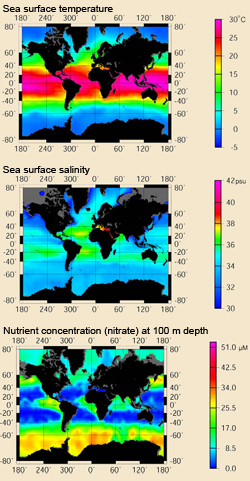
 Zoom Levitus maps
Zoom Levitus maps